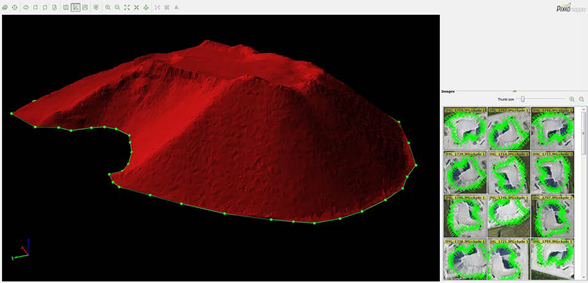How accurate are UAV surveying methods?
How accurate is UAV surveying? Testing stockpile volumetrics to get your answer. A comparison between Pix4D UAV photogrammetry software and GNSS / terrestrial LIDAR scan surveys.
Introduction
One of the first questions asked when considering the use of UAV surveying methods for stockpile volumetric is about expected accuracy. Though this common question looks simple at first sight, it is not trivial to answer. Reason why Pix4D set up a stockpile test case to give first answers when comparing the use of Pix4D’s UAV image processing software (Pix4Dmapper) with terrestrial LIDAR scan and GNSS point surveys . The obtained results prove it: UAV’s are ideally suited for stockpile volume measurements with a mean difference of only some centimetres when compared to the surface obtained with terrestrial LiDAR or GNSS test points. In addition, results are comparable to traditional photogrammetry results yielding 2 to 3 GSD all the while using lower quality UAV imagery and a fully automatic workflow.
The test sites
The case study was performed on two different sites: Site A contains several gravel / sand stockpiles as well as an asphalt road and some farmland with sparse vegetation. The stockpiles show trapezoidal cross sections and have heights between 7 to 10m. This site possesses good photogrammetric underground textures. It was used for comparison with terrestrial GNSS survey points.
Site B contains a sparsely vegetated earth protection dam against rockfall, several gravel stockpiles and an asphalt road. This site was used for the comparison with a terrestrial LIDAR scan as well as for crosschecking with GNSS survey points.
The surveying equipment
Both flights were performed with senseFly fixed wing UAVs equipped with 16 megapixel consumer grade Canon Ixus cameras. Flights for site A (gravel stockpile) were at an altitude of 130 to 150 m above ground, achieving a ground sample distance (GSD) of 5 cm. A total of 86 images were acquired using an overlap of 93%.For site B, 212 images with an overlap of 93% were acquired, achieving a GSD of 5 cm with a flight at 120 to 140 meters above ground.
To measure the photogrammetric ground control points (GCPs) and terrestrial verification points a surveyor grade dual frequency RTK GNSS receiver was used attaining elevation precision of 3 to 5 cm. In total, some 500 ground points were sampled. For the LIDAR survey, a Riegl VZ400 laser scanner was employed on site B, with two survey stations that were georeferenced by means of GNSS survey points. With this type of scanner and at a scanning distance up to several 100 m, the relative point accuracy is generally expected to be at or below 5 mm.
Time investment for all 3 methods were equivalent due to the small area surveyed (above 2 to 5 hectares, using UAV technology will significantly improve efficiency and reduce time investment).
Used terminology
The ground sample distance (GSD) is a term from remote sensing to describe the pixel resolution measured on the ground. For example in an image with 5 cm GSD, a pixel corresponds to 5 cm on the ground. The value depends mainly on the camera sensor resolution, focal length and flying height.
Ground control points (GCP) are well identifiable landmarks on the ground of known location. They are used both to reference the photogrammetric model with an established local or national coordinate system as well as improve the overall accuracy of the model.
GNSS is a general term for global navigation satellite systems that include, among others, the navigation systems GPS (USA), GLONASS (Russia), Compass (China) and Galileo (Europe). With modern 2 frequency receivers and differential correction signals it is possible to determine survey points up to an accuracy of few centimetres.
How to determine stockpile volumes?
Stockpile volumes can be determined using different methods. The traditional approach is by surveying characteristic breaklines or by planimetry, where the volume is calculated by interpolating and summing up cross sections/profiles along an axis. However, with today’s simple and rapid to use GNSS receivers, terrestrial laser scanners, and the newly introduced close range aerial photogrammetry the tendency is clearly to cover the stockpile surface with a dense point network instead of simple cross sections or a few breaklines. Powerful tools in standard GIS and CAD software then allow very precise volume calculations by subtracting the surveyed surface from a former existing surface or a virtual reference plane. A third and still very popular method is by assuming a bulking factor for a given material, then multiply it by the number of dumper transports. This method only applies where the mass movements can be followed strictly. Our study focused mainly on volumetric analysis by subtracting surfaces.
How to determine volume accuracy?
The question about volume accuracy is not trivial to answer as it is mostly expressed in a percentage error margin. It is equally impossible to generalize it for the differential surface volumetric calculations, mainly because the volume accuracy not only depends on the accuracy of the stockpile surface, but also on the stockpile height/thickness. The diagram below illustrates this principle. As it can be seen in this example, the volume accuracy of a 10 meter high stockpile is less sensitive to surface errors than a 3 meter thin landfill.
How we tested the datasets?
For reasons mentioned in the previous paragraph, we omitted in a first step accuracy estimation on volumes and concentrated on accuracy of stockpile surfaces and we generally use the Pix4D output surface as reference plane. This plane originates from a dense point cloud, which was filtered and sampled to a DSM grid at 5cm resolution. The processing settings within Pix4D software were left to standard values, in order to get a neutral, repeatable result. The Pix4D DSM was then statistically compared to two different types of datasets acquired with terrestrial measures. First we compared the elevation values from the DSM to 500 single point surveys from a GNSS device. We then compared the elevation values with an area of about 10’000 m2 that was scanned with a LIDAR device. Most of the single point locations as well as the LIDAR scan sector were selected such as they could be easily identified both from the air and from the ground and preferably possessed no or few vegetation.
Results comparing the DSM produced by Pix4D with the GNSS verification points
The histogram below shows a statistical analysis of the elevation differences between the Pix4D DSM and the GNSS verification points. A positive value indicates that the Pix4D surface is higher than the GNSS-verification point and vice versa. For test site A and B separate histogram graphs were plotted.

 Fig. 3 and 4: elevation difference histogram between GNSS verification points and Pix4D DSM surface for test site A and B. Fig. 5: elevation difference histogram between GNSS verification points and LIDAR based surface.
Fig. 3 and 4: elevation difference histogram between GNSS verification points and Pix4D DSM surface for test site A and B. Fig. 5: elevation difference histogram between GNSS verification points and LIDAR based surface.
The present cases showed that generally 95% of the points sampled on the Pix4D DSM lie within a +/- 15 cm interval when compared to the GNSS points, corresponding to 3 times the ground sampling distance (GSD). The deviation of the Pix4D surface and the GNSS verification points averages at +3 to +4 cm, where it should be taken into account that the accuracy of GNSS reference points lies as well ‘only’ within 3 to 5cm. The distribution is not perfectly Gaussian and shows a slight bulge on the positive side, possibly due to the remaining vegetation and certain filtering effects.
Results comparing the DSM produced by Pix4D with the LIDAR surface
The histogram below shows a similar statistical analysis of the elevation differences between the DSM produced by Pix4D and the surface scanned with LIDAR. Some 2.7 Mio points were compared.

The mean deviation between the Pix4D surface and the LIDAR surface is about 3 cm. 2/3 of the test points lie within 2 GSD and ¾ of the test points are within 3 GSD, reaching the same level as best possible results theoretically achievable with any photogrammetry method, even when using lower quality UAV imagery. While for the considered application such an error is marginal, more precise results can be obtained using either a higher quality camera or reducing the flight altitude.

 Fig. 7: Rendering of the point clouds from Laser scanning (top) and UAV Photogrammetry (bottom) from the same viewpoint for the comparison in figure 8. One can appreciate a very dense sampling of the laser point cloud in the close range to the scanner and a decreasing sampling rate and accuracy for points further away. The photogrammetric point cloud shows a more uniform sampling since it was computed from aerial images at an approximately constant ground sampling distance
Fig. 7: Rendering of the point clouds from Laser scanning (top) and UAV Photogrammetry (bottom) from the same viewpoint for the comparison in figure 8. One can appreciate a very dense sampling of the laser point cloud in the close range to the scanner and a decreasing sampling rate and accuracy for points further away. The photogrammetric point cloud shows a more uniform sampling since it was computed from aerial images at an approximately constant ground sampling distance
 Fig. 8: Top view with colour coded deviation between LIDAR survey zones and Pix4D DSM.
Fig. 8: Top view with colour coded deviation between LIDAR survey zones and Pix4D DSM.
From surfaces to volumes
For the relative volume comparison, we designated for site A and B three distinct, small-scale stockpiles to calculate their volumes. Using a standard GIS software, the calculation was performed by subtracting the actual stockpile surfaces from a theoretical reference plane at the base of the stockpiles. The GNSS points were used to build a triangular irregular network (TIN) surface while the initially created 5cm DSM grids were used for the UAV photogrammetry and LIDAR data. A summary of the results are shown in the table below.
In addition to this relative volume comparison between different methods, we can also estimate an absolute error potential of the Pix4D volume. Comparing the Pix4D surface against the GNSS single points previously or the LIDAR surface, we know that the mean overall deviation lies between -2 to 4 cm. Taking into consideration the randomly selected sample locations and the sample number, we can assume that this range is not only valid for some points but the complete surface. This leads to the conclusion that we expect a maximal volume error between 440 and 1’330 m3 for the total investigated stockpile areas, equalling to 0.3 to 0.8 % of the total volume. While this very simplistic conclusion is admittedly only valid for the specific stockpile scenario, it nevertheless indicates a rough estimation on the maximal error cap for our test case.
Conclusion
Based on the present case study we can conclude that with UAV photogrammetry, volume calculation based on the method of surface difference is achieved with the accuracy needed to comply with practical surveyor requirements. The study results show that the overall mean elevation of these surfaces only deviate within centimetres from the “true” surface. This is mainly achieved through the high resolution of the surface models despite the fact that the single point elevations actually show a variation/noise of up to 3 times the GSD. For the considered application such an error is marginal and, if required, surveyors have the possibility to obtain more precise results using either a more adapted camera or reducing the flight altitude.
While traditional surveying methods are still an interesting alternative for small surfaces, UAV photogrammetry is unmatched in terms of efficiency for surfaces above several hectares all the while producing equivalent accuracy. In addition, using the UAV surveying method not only produces a DSM but also a geo-referenced, highly detailed orthomosaic, an important added-value for stockpile site documentation.





Leave a Reply
Want to join the discussion?Feel free to contribute!